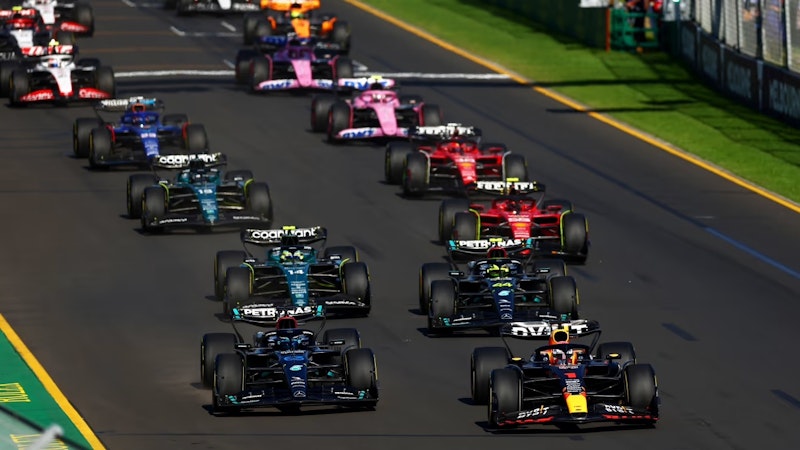On February 1st, it was announced that Formula 1 driver Lewis Hamilton would move from Mercedes, where he’s spent the last decade—the World Drivers Champion for six of those past 10 years—to Ferrari. It wasn’t just the biggest news story in racing, but in all of sports for the day: one of the greatest living drivers signing on to the most iconic racing outfit for the twilight of his career at the world’s premier series. Hamilton’s unbelievable success after his Mercedes move mixed with his straight-from-the-movies underdog story has turned him into one of the most consistently marketable athletes in the world, making this driving deal worth a lot of money. Ferrari’s stock went up six percent after the announcement, nearly $6 billion in value. It makes the rumors that Hamilton could be earning almost $100 million a year driving for the Scuderia seem like peanuts.
It’s an era of big money. In 2016, Ferrari’s CEO Sergio Marchionne exclaimed, “You’d have to shoot me first!” before the legacy brand would cash in and make an SUV. Marchionne died in 2018 and John Elkann succeeded him as chairman, bringing the Purosangue to market in 2022, which boosted the stock price of the company 70 percent and revenues up 27 percent in 2023 compared to the previous year. From Marchionne’s declaration to the fat four-door “Ferrari Utility Vehicle” hitting the streets, the SUVs had gone from being about 30 percent of new cars to over half.
Elkann’s a money man, and he’s been identified as the key player in getting Hamilton to sign with the Scuderia. Although some fans have been critical of him theoretically side-stepping Ferrari’s F1 team principal Fred Vasseur—which is ridiculous considering Vasseur has known Hamilton for over 20 years, including managing Hamilton at ART Grand Prix in his GP2 title winning season in 2006 (which was at the time the top feeder series for F1)—many forget that the name of the game in F1 at this point is only money. There’s a good story here that could be ready for fireworks: Hamilton is stepping into a team led by an up-and-coming driver who’s yet to win a title, and a team known in its recent memory as picking up old champions and spitting them back out after failing to deliver wins, titles, or any of the overall competence expected from top teams. But as four-time F1 champion and later Ferrari dropout Sebastian Vettel once said, “Everyone’s a Ferrari fan.” Everyone would want to wear the red, including Lewis Hamilton. There’s a personal bend to Hamilton’s decision even if it cynically could be classified as a commercial deal.
From the managerial side, though, it should only be read for its bottom line. The Hamilton-Ferrari news broke not 24 hours after it was announced that Andretti-Cadillac was rejected from joining the F1 as an 11th team. The rejection was expected as president of Formula One Group, led by former Ferrari team principal Stefano Domenicali (who picked up the role in 2008, kickstarting the team’s decline and their now-15 year absence from winning either driver’s or constructor’s championship), made it clear they didn’t want another team on the grid, despite opening the application process. Their logic for denial was shoddy at best, but reading between the lines it was obvious that the whole fiasco is about financial value.
Ever since the Liberty Media buyout of the sport in 2017 and its post-2019 boom in popularity, F1 has moved away from its traditional ad hoc club system towards a more American type franchise model for teams. It’s led to weird scenarios, like where the struggling historic racing outfit Williams is now basically a holding company for shadowy investors or the godawful Haas team somehow has its worth skyrocket with the overall value of the sport despite them doing nothing about competitiveness and can’t even raise enough funds to meet the cost-cap. The closed system is proving to be profitable, and FOM have done everything to maintain their and their teams’ corporate control in their little boom economy.
Even the best prospects, like one of the most prominent and successful racing families (Andretti) partnering with the largest auto manufacturer in the US (General Motors), cannot get through the gates because it fundamentally cuts into other people’s profits. FOM had already established a necessary $200 million “anti-dilution” fund to be paid by a theoretical new entrant to all the existing teams to make up for the split in prize money they’d be taking. That price is expected to go up to a ridiculous $600 million after the commercial rights agreements for F1 are renewed in 2026. It’s everyone in the highly-profitable closed circle telling everyone else to pay up or fuck off, and if they wanna join the club they better think twice if they think there’s gonna be any money in it for them too.
But it does call into question priorities: when did F1 become about money? It was always about money, but not exactly making money. It was a sport where bankers’ sons went to drive around in circles with vainglory, and fortunes were squandered fighting over shiny cups. But now, really for the first time proper in its history, the sport itself can make money, not just from cigarette ads and car sales, but a comically modern Silicon Valley kind of money made up of ones and zeros on computer networks. Andretti’s going to fight F1 on this, sinking every last penny it takes to get on track, making them the only real racers of old left in the business.

